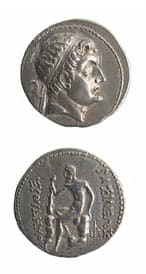Bactrian Silver Tetradrachm of King Euthydemos I, 230 BCE - 200 CE
Silver
C.3043
Obverse: Head of Euthydemos Crowned with a Diadem Reverse: Nude Herakles Resting on a Rock Holding a Club Few details are known about the life of Euthydemos I. He was...
Obverse: Head of Euthydemos Crowned with a Diadem
Reverse: Nude Herakles Resting on a Rock Holding a Club
Few details are known about the life of Euthydemos I. He was possibly the Satrap of Sogdiana, a historical region in Central Asia just north of modern Afghanistan. Just as Diodotus I, while serving as Satrap of Bactria, had earlier rebelled against his Seleucid overlords and declared independence for his kingdom, Euthydemos I in turn overthrew the dynasty of Diodotus and became king of Bactria around 230 B.C. It is not until 208 B.C., when Seleucid King Antiochus III invades Bactria, that Euthydemos again enters the historical record. Despite losses in their early battles, the Bactrians were successfully able to hold off the Seleucids during a three year siege of the fortified city of Bactra. The war ended with official recognition of Euthydemos as the ruler of an independent Bactria and a royal marriage between his son Demetrius and one of Antiochus’ daughters around 206 B.C. It is believed Euthydemos eventually died around 200 B.C. and it is likely that his last days saw the beginning of the Bactrian invasion of India, a conquest that would be completed by his son Demetrius who succeeded him.
How many hands have touched a coin in your pocket or your purse? What eras and lands have the coin traversed on its journey into our possession? As we reach into our pockets to pull out some change, we rarely hesitate to think of who touched the coin before us, or where the coin will venture to after us. More than money, coins are a symbol of the state that struck them, of a specific time and place, whether contemporary currencies or artifacts of long forgotten empires. This stunning hand-struck coin reveals an expertise of craftsmanship and intricate sculptural detail that is often lacking in contemporary machine-made currencies. This coin is a memorial an ancient king and his empire passed from the hands of civilization to civilization, from generation to generation that still appears as vibrant today as the day it was struck.
Reverse: Nude Herakles Resting on a Rock Holding a Club
Few details are known about the life of Euthydemos I. He was possibly the Satrap of Sogdiana, a historical region in Central Asia just north of modern Afghanistan. Just as Diodotus I, while serving as Satrap of Bactria, had earlier rebelled against his Seleucid overlords and declared independence for his kingdom, Euthydemos I in turn overthrew the dynasty of Diodotus and became king of Bactria around 230 B.C. It is not until 208 B.C., when Seleucid King Antiochus III invades Bactria, that Euthydemos again enters the historical record. Despite losses in their early battles, the Bactrians were successfully able to hold off the Seleucids during a three year siege of the fortified city of Bactra. The war ended with official recognition of Euthydemos as the ruler of an independent Bactria and a royal marriage between his son Demetrius and one of Antiochus’ daughters around 206 B.C. It is believed Euthydemos eventually died around 200 B.C. and it is likely that his last days saw the beginning of the Bactrian invasion of India, a conquest that would be completed by his son Demetrius who succeeded him.
How many hands have touched a coin in your pocket or your purse? What eras and lands have the coin traversed on its journey into our possession? As we reach into our pockets to pull out some change, we rarely hesitate to think of who touched the coin before us, or where the coin will venture to after us. More than money, coins are a symbol of the state that struck them, of a specific time and place, whether contemporary currencies or artifacts of long forgotten empires. This stunning hand-struck coin reveals an expertise of craftsmanship and intricate sculptural detail that is often lacking in contemporary machine-made currencies. This coin is a memorial an ancient king and his empire passed from the hands of civilization to civilization, from generation to generation that still appears as vibrant today as the day it was struck.
